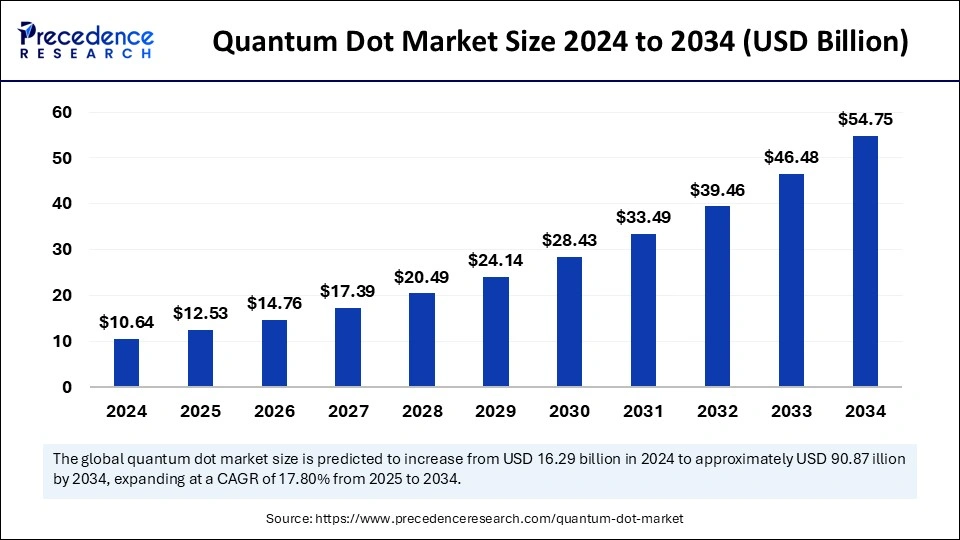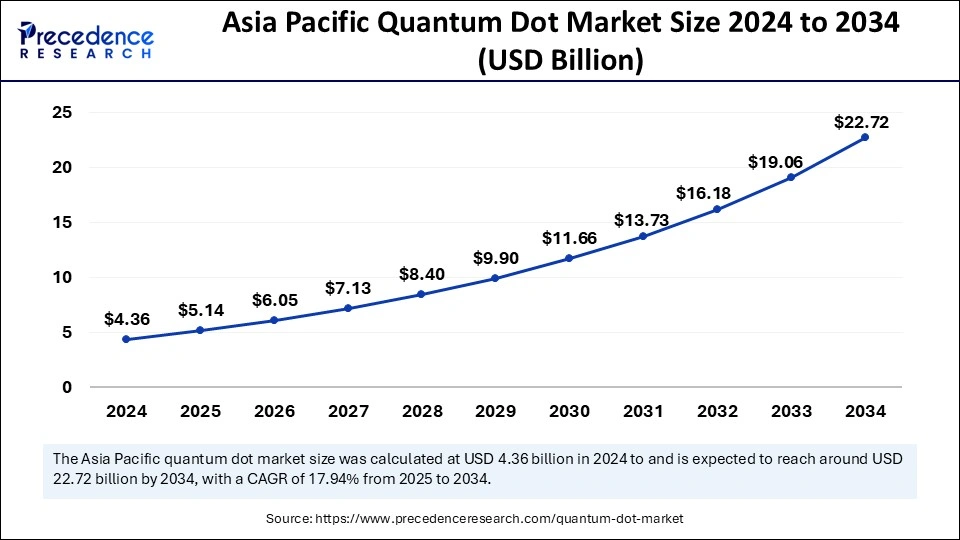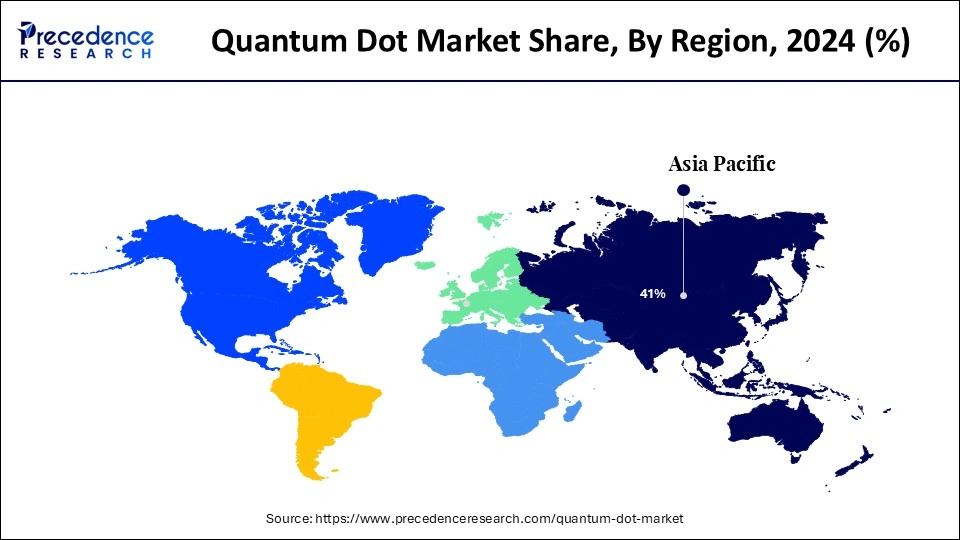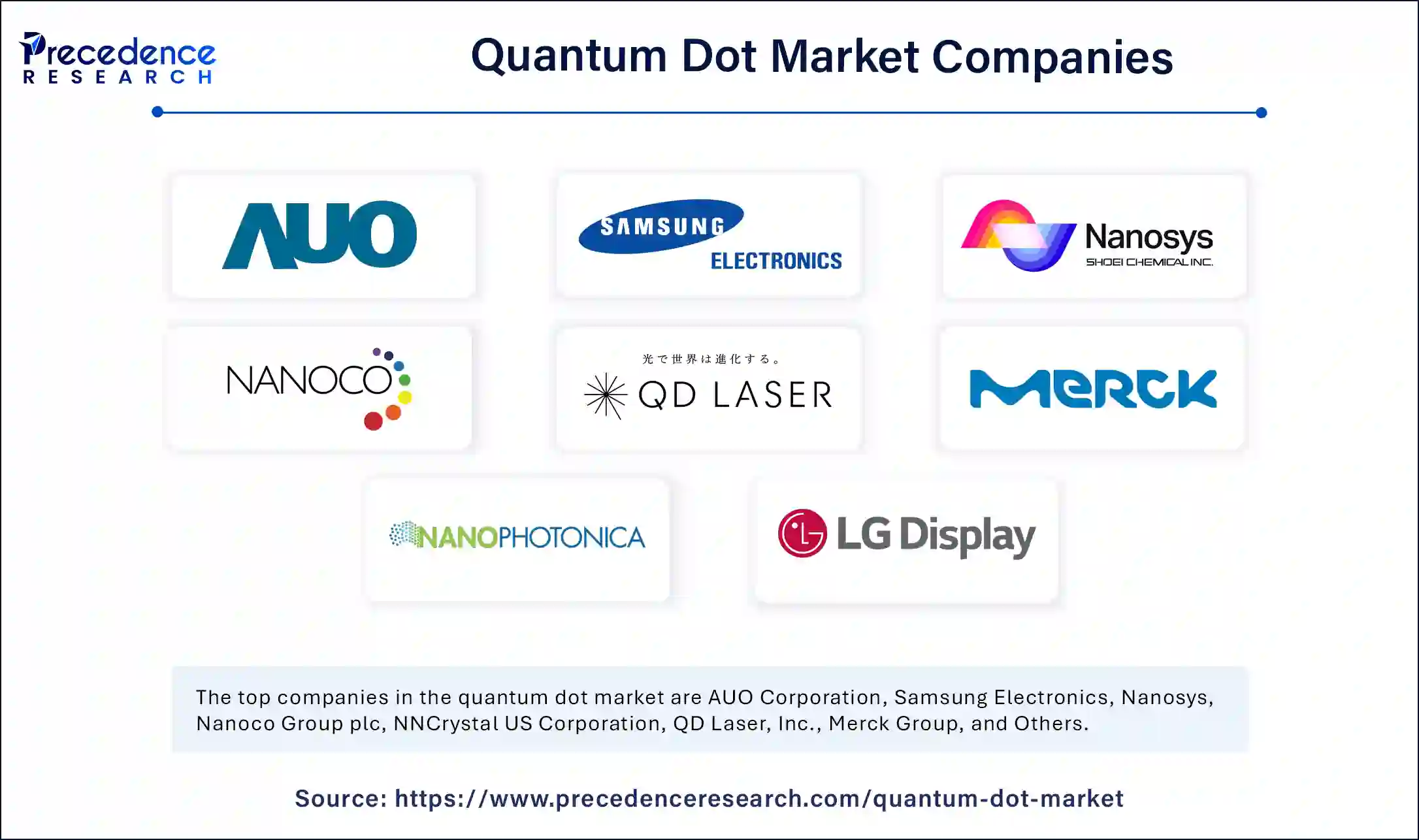March 2025
The global quantum dot market size is calculated at USD 12.53 billion in 2025 and is forecasted to reach around USD 54.75 billion by 2034, accelerating at a CAGR of 17.80% from 2025 to 2034. The Asia Pacific market size surpassed USD 4.36 billion in 2024 and is expanding at a CAGR of 17.94% during the forecast period. The market sizing and forecasts are revenue-based (USD Million/Billion), with 2024 as the base year.
The global quantum dot market size was estimated at USD 10.64 billion in 2024 and is predicted to increase from USD 12.53 billion in 2025 to approximately USD 54.75 billion by 2034, expanding at a CAGR of 17.80% from 2025 to 2034. The market is expanding at a rapid pace due to the rising utilization of quantum dots in electronic devices.

Artificial intelligence (AI) plays a significant role in the market, unlocking avenues for innovations in quantum dots. AI can optimize the synthesis processes of quantum dots, enhancing design and performance. AI is also beneficial in the research and development of quantum dots, enabling researchers to find innovative materials with enhanced characteristics that have a higher probability of success. With AI and machine learning (ML) algorithms, large sets of data can be analyzed to predict properties or features of quantum dots that are yet to be synthesized. AI-driven tools help identify suitable compositions, structures, or sizes for particular applications, which helps accelerate discovery processes. Integration of AI algorithms in quantum dot-based devices can help in performance optimization, for example, synaptic devices that are used for neuromorphic computing.
The Asia Pacific quantum dot market size was exhibited at USD 4.36 billion in 2024 and is projected to be worth around USD 22.72 billion by 2034, growing at a CAGR of 17.94% from 2025 to 2034.

Asia Pacific registered dominance in the quantum dot market by holding the largest share in 2024. The region’s dominance is mainly attributed to the high demand for consumer electronics, such as smartphones, TVs, and laptops. The strong presence of leading electronics manufacturers also plays an important part in market growth. Increased government initiatives to promote solar energy further support regional market growth. With regulations related to clean energy, many businesses and consumers are adopting solar systems, boosting the demand for QDs for solar cells. An increase in research and development activities for quantum dots further bolstered market growth.
China stands out as a major marketplace in the market in Asia Pacific. The country is known as the major manufacturing hub for electronic devices. The increasing production of electronic devices is expected to boost the demand for quantum dots. In addition, the increasing demand for energy-efficient displays contributes to market expansion.

North America is expected to witness the fastest growth during the forecast period. The rising emphasis on quantum dot research to explore its scope of applications is expected to support regional market growth. The U.S. can have a stronghold on the North American quantum dot market. The U.S. is home to some of the leading semiconductor companies like Intel and NVIDIA. There is a high demand for high-end consumer electronics with advanced displays, supporting market expansion. The rapid shift toward renewable energy sources and increasing investments in solar systems further contribute to market growth.
Europe is seen to grow at a notable rate in the foreseeable future. The increasing adoption of solar energy is expected to boost the growth of the market. There is a high demand for HD displays and optical devices. This country has an established automotive manufacturing industry that supports market growth. Countries like Germany, France, and the UK are major contributors to the market. The rising demand for LED products, especially in the automotive industry, and increasing investments in solar-powered devices further support market expansion.
Quantum dots (QDs) are small crystals that have the capacity to transport electrons. The strike of UV light on these semiconducting nanoparticles emits different colors. Their unique optical and electronic properties make them suitable for various applications, ranging from high-definition displays to solar cells and sensors. The growing utilization of quantum dots in consumer electronics, display technologies, and biomedical applications is boosting the growth of the quantum dot market. The demand for consumer electronics is skyrocketing across the world, which is expected to boost the demand for quantum dots.
The rising adoption of QDs in medical devices, such as imaging, diagnosis, and drug delivery systems, is further propelling the market’s growth. With the growing concerns about governmental conservation, there is a rapid shift toward renewable energy sources, such as solar cells, in which QDs play a crucial role. The growing popularity of quantum dot-based computing is also fueling market growth. The increasing investment in quantum dot research further contributes to market expansion.
| Report Coverage | Details |
| Market Size by 2034 | USD 54.75 Billion |
| Market Size in 2025 | USD 12.53 Billion |
| Market Size in 2024 | USD 10.64 Billion |
| Market Growth Rate from 2025 to 2034 | CAGR of 17.80% |
| Dominating Region | Asia Pacific |
| Fastest Growing Region | North America |
| Base Year | 2024 |
| Forecast Period | 2025 to 2034 |
| Segments Covered | Material, Product, and Regions |
| Regions Covered | North America, Europe, Asia-Pacific, Latin America, and Middle East & Africa |
Demand for Energy-Efficient Devices
The rising demand for energy-efficient electronic devices is a key factor driving the growth of the quantum dot market. Traditional display technologies and lighting systems lack display quality and efficiency, reducing performance. However, quantum dots are capable of providing enhanced color in displays and lighting, improving consumer experience. These dots have unique abilities that allow the light to be converted in a more efficient manner. They convert electricity into light using less energy, optimizing the overall energy usage of a device. With the growing concerns of energy wastage, the adoption of quantum dots is increasing in electronic devices, especially those with displays, to make them more energy efficient.
Regulatory Compliances
The quantum dot market faces several challenges because of stringent regulations regarding toxic materials. Governments around the world have imposed strict norms to reduce the environmental impact of toxic materials. These regulations differ from region to region, creating challenges for quantum dot manufacturers. Since quantum dots contain toxic materials, they require proper handling and disposal. Manufacturers are required to adhere to these standards while scaling up as well as dispose of quantum dots. This, in turn, increases the costs of production, which is reflected in the price of final products.
Expanding Applications in Solar Cells
The expanding applications in solar cells create immense opportunities in the quantum dot market. QDs have the ability to improve the efficiency of converting sunlight into energy, making them suitable for solar cells. The effective absorption of large portions of the solar spectrum by quantum dots allows for a more efficient way of conversion of sunlight into electricity. They are also suitable for use in solar-powered electronic devices. The rise in the installation of solar panels is expected to support market growth in the coming years. People are becoming more aware of the benefits of renewable energy sources, boosting the adoption of solar energy worldwide. Moreover, the rapid urbanization and increasing government incentives to promote solar energy are expected to boost the usage of QDs in solar-powered devices.
The cadmium-based segment dominated the quantum dot market in 2024. Cadmium-based quantum dots are widely preferred because of their unique properties in optical as well as electronics. These QDs are able to be tuned by controlling their size, which expands the scope of their applications in solar cells and displays. The broad scope of applications of cadmium-based quantum dots bolstered the segment growth.
On the other hand, the cadmium-free segment is projected to grow at the fastest rate during the forecast period. With the rising regulations on the utilization of heavy metals because of their toxicity and unsustainability, the adoption of cadmium-free quantum dots is increasing. The non-toxic and environmentally friendly nature of cadmium-free QDs make them viable for various applications. They are heavily used in electronics and healthcare devices.
The displays segment led the quantum dot market in 2024. This is mainly due to the rise in the production of consumer electronics. Quantum dots are known for their capability to produce pure and vibrant colors, which makes them ideal for displays. This allows the device displays to have high color fidelity, making them popular for high-end monitors, TVs, and mobile devices. The superior color quality can be achieved with quantum dots. The rise in demand for HD displays further augmented the segment.
Meanwhile, the LED products segment is anticipated to expand at the fastest rate in the upcoming period. QDs enhance color accuracy and improve the brightness and efficiency of LED products. The rising demand for QD-LEDs is a key factor boosting the growth of the segment. QD-LEDs are ideal for manufacturing HD displays. They are widely used in screens of TVs, laptops, tablets, and smartphones.

By Material
By Product
By Region
For inquiries regarding discounts, bulk purchases, or customization requests, please contact us at sales@precedenceresearch.com
No cookie-cutter, only authentic analysis – take the 1st step to become a Precedence Research client
March 2025